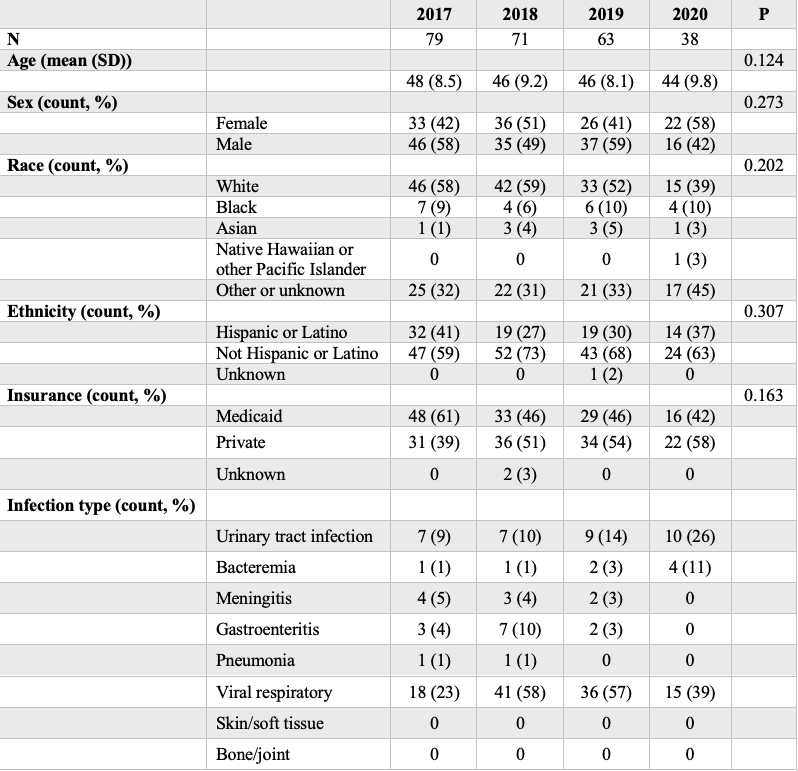Emergency Medicine: All Areas
Category: Abstract Submission
Emergency Medicine III
64 - High-Risk Markers and Infection Rates in Febrile Infants aged 29-60 days Presenting to the Emergency Department During the COVID-19 Pandemic Compared with Previous Years
Friday, April 22, 2022
6:15 PM - 8:45 PM US MT
Poster Number: 64
Publication Number: 64.105
Publication Number: 64.105
Kathryn Schissler, Connecticut Children's Medical Center, West Hartford, CT, United States; Sidney Stewart, Connecticut Children's Medical Center, Hartford, CT, United States; TIMOTHY PHAMDUY, Connecticut Children's Medical Center, Hartford, CT, United States; Michael Brimacombe, Connecticut Children's Medical Center, Hartford, CT, United States; Ilana Waynik, Connecticut Children's Medical Center (Hartford, CT), West Hartford, CT, United States; Eric Hoppa, University of Connecticut School of Medicine, Avon, CT, United States

Kathryn Schissler, DO
Attending
Hasbro Children's Hospital, Brown University
Providence, Rhode Island, United States
Presenting Author(s)
Background: During the COVID-19 pandemic there was a change in the utilization of the emergency department (ED) for many reasons, including a decrease in transmission of communicable childhood infections and avoidance of situations that could result in exposure. Caregivers are educated to bring febrile neonates to the ED, however for infants aged 29-60 days, there may not be the same urgency especially during a pandemic. In this population there may have been a delay in ED presentation, leading to patients presenting with increased clinical and laboratory markers associated with a higher risk of serious bacterial infection.
Objective: To evaluate how the pandemic affected the clinical and laboratory high-risk markers as well as infection rate in infants aged 29-60 days presenting to the ED with fever.
Design/Methods: Retrospective chart review of infants evaluated in the ED from March 11-December 31, 2017-2020. Patients were identified using a dataset derived from the hospital’s clinical pathway. Inclusion, exclusion and high-risk criteria are included in Table 1. Data was reviewed by quality data specialists and then by a physician to ensure proper categorization and infectious diagnosis. Patient demographics, categorization as high-risk, and type of infection were collected (Table 2). Data was analyzed using chi-square and Fisher exact tests. A p-value < 0.05 was considered significant.
Results: 251 patients over the 4 years met inclusion criteria. The ED visits for this patient population decreased in 2020 compared to prior years. The proportion of visits for this patient population to all ED visits remained similar across all 4 years (p = 0.66). There was no significant difference in patient demographics as seen in Table 2. Year 2020 had the highest rate of urinary tract infection (26%) and bacteremia (11%). The rate of the high-risk criteria of ill-appearance, white blood cell count (WBC), and urinalysis (UA) were highest in 2020 (Figure 1). Comparison of the cumulative data from 2017 through 2019 to 2020 data showed a significant difference in the proportion of patients presenting with high-risk WBC (p = 0.028) and UA (p = 0.034) but no significant difference in high-risk ill-appearance (p = 0.208).Conclusion(s): In 2020 there was a higher rate of urinary tract infections and bacteremia as well as a significantly greater proportion of patients presenting with high-risk WBC and UA in this population. This suggests that during the COVID-19 pandemic, a lower rate of community viral infection due to pandemic mitigation strategies and possibly later presentation of febrile infants to the ED led to these results.
Kathryn Schissler CV .pdf
Table 2
Objective: To evaluate how the pandemic affected the clinical and laboratory high-risk markers as well as infection rate in infants aged 29-60 days presenting to the ED with fever.
Design/Methods: Retrospective chart review of infants evaluated in the ED from March 11-December 31, 2017-2020. Patients were identified using a dataset derived from the hospital’s clinical pathway. Inclusion, exclusion and high-risk criteria are included in Table 1. Data was reviewed by quality data specialists and then by a physician to ensure proper categorization and infectious diagnosis. Patient demographics, categorization as high-risk, and type of infection were collected (Table 2). Data was analyzed using chi-square and Fisher exact tests. A p-value < 0.05 was considered significant.
Results: 251 patients over the 4 years met inclusion criteria. The ED visits for this patient population decreased in 2020 compared to prior years. The proportion of visits for this patient population to all ED visits remained similar across all 4 years (p = 0.66). There was no significant difference in patient demographics as seen in Table 2. Year 2020 had the highest rate of urinary tract infection (26%) and bacteremia (11%). The rate of the high-risk criteria of ill-appearance, white blood cell count (WBC), and urinalysis (UA) were highest in 2020 (Figure 1). Comparison of the cumulative data from 2017 through 2019 to 2020 data showed a significant difference in the proportion of patients presenting with high-risk WBC (p = 0.028) and UA (p = 0.034) but no significant difference in high-risk ill-appearance (p = 0.208).Conclusion(s): In 2020 there was a higher rate of urinary tract infections and bacteremia as well as a significantly greater proportion of patients presenting with high-risk WBC and UA in this population. This suggests that during the COVID-19 pandemic, a lower rate of community viral infection due to pandemic mitigation strategies and possibly later presentation of febrile infants to the ED led to these results.
Kathryn Schissler CV .pdf
Table 2

